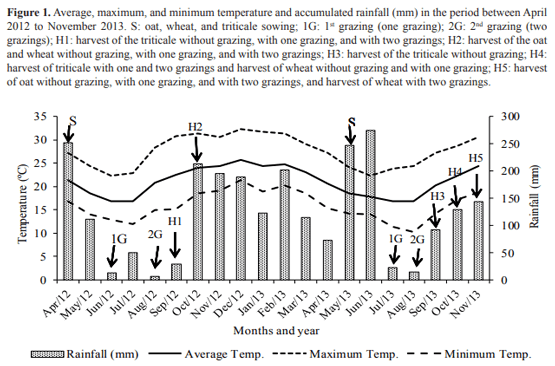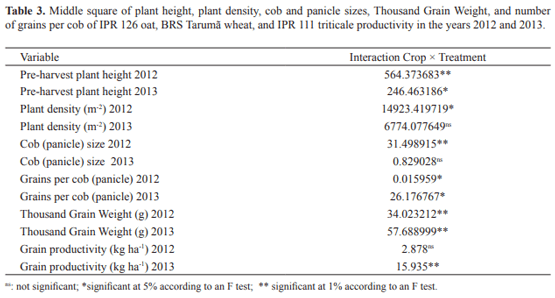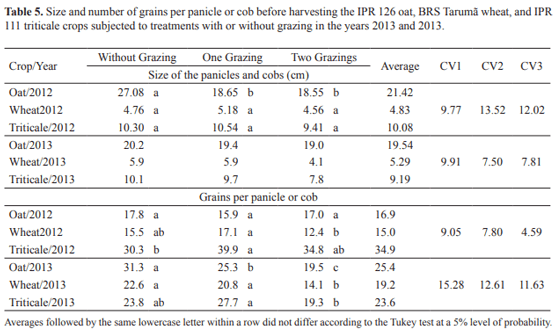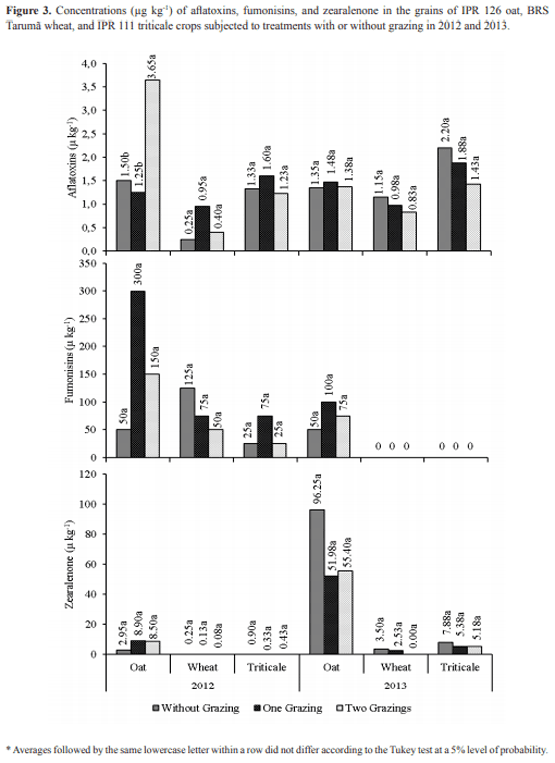Introduction
In southern Brazil, crop-livestock integration (CLI) is an alternative to the rotation system, which uses winter grains in succession to summer crops and allows for more efficient use of the soil. Crop rotation provides the property with higher diversity, lowering the economic risk of only producing grains, and improves the soil (SANTOS et al., 2013a). In western Paraná, where there is a rotation between soy in summer and corn in winter, crop rotation can be adapted to use CLI with dual-purpose winter grains.
For CLI with dual-purpose crops to be successful, there must be proper soil fertility, sowing at the appropriate time, and the right amount of rainfall. It is also important that there is no excessive trampling so that the soil porosity is not compromised, as this consequently impairs water infiltration and soil aeration, which contributes to the development of the summer crops’ deep roots. In addition, the end of the grazing period must be before the elongation of the internodes of the plants, and must be timed so that the residual height of the crops assures a minimum of 2 t ha-1 of haystack on the stubble (BARTMEYER et al., 2011; CRUZ et al., 2010; HASTENPFLUG et al., 2011).
The regrowth of dual-purpose winter crops must be such that there is rapid formation of new leaves, to assure the production of photoassimilates necessary for grain formation. During leaf growth, there is a mobilization of carbohydrates and a progressive increase in the absorption of nitrogen, which reaches its peak during the reproductive stage and decreases during the grain-filling phase (HASTENPFLUG et al., 2011).
Cuts or grazing and fertilization levels can affect the production components (such as plant height, size of the cobs and panicles, plant density, the mass of one thousand grains (Thousand Grain Weight (TGW)), and grains per cob) of the winter crops used in CLI systems. These production components are directly related to the yield and quality of the winter crop grains (HASTENPFLUG et al., 2011). Grazing must be continued, regardless of the system put into place, whether rotated or continuous, until the plants reach the recommended height for the species, so that there is high performance and high forage quality. At the same time, the increase in soil quality and the reduction of compaction due to trampling (BALBINOT JUNIOR et al., 2009) must be controlled in a way that preserves, recovers, or increases soil fertility (HENZ et al., 2016). This way, livestock grazing will be seen as an activity that facilitates diversification and a higher income per area, and reduces agricultural risks (BALBINOT JUNIOR et al., 2009), especially when the goal is dual-purpose: cattle grazing and harvest (AMBROSI et al., 2001).
On the other hand, cereal grains can be contaminated by mycotoxins in the field or in storage. Grazing of winter crops increases the length of the crop cycle, exposing them to cold and damp or warm and damp conditions, both of which are favorable environments for the development of fungi, leading to mycotoxin contamination (NIELSEN et al., 2011).
It is estimated that approximately 25% of the world’s agricultural products are contaminated by mycotoxins (IAMANAKA et al., 2010). Five types of mycotoxins are considered of economic interest: aflatoxins, zearalenone, fumonisins, ochratoxin A, and trichothecenes (LINO et al., 2004).
Thus, the aim of this study was to evaluate the agronomic characteristics, crop productivity, and the presence of mycotoxins aflatoxins, fumonisins, and zearalenone in oat, wheat, and triticale grains that were used in a CLI system.
Materials and Methods
The project was conducted between April 24, 2012 and November 11, 2013 on UNIOESTE’s Experimental Farm (latitude 24°31′56.1″S; longitude 54°01′10.3″W; approximate altitude of 400 m a.s.l.), Marechal Cândido Rondon Campus (PR, Brazil), on Dystrophic Red Latosol (Oxisol) (SANTOS et al., 2013b).
The climate in this region, according to Köppen’s classification, is Cfa, or subtropical humid mesothermal with dry winters, rain well distributed throughout the year, and warm summers. The average temperatures of the coldest trimester (Mai, June and July) vary between 17 and 18°C, in the warmest trimester (December, January and February) are between 28 and 29°C, and the annual average temperature is between 22 and 23°C. The normal total annual average rainfall for the region varies between 1600 and 1800 mm, with the most humid trimester receiving between 400 and 500 mm (CAVIGLIONE et al., 2000).
The climate data regarding the experimental period (April 2012 to November 2013) were obtained from a climatological station that belongs to UNIOESTE/Marechal Cândido Rondon and is approximately 50 m from the experimental area (Figure 1).
The experimental area was being maintained under the direct sowing system and, due to its chemical characteristics (Table 1) in which its base saturation was below 50%, liming by applying agricultural limestone was performed (Relative Power of Total Neutralization - PRNT 85%) before sowing of winter crops (March 2012); and before the soy crop (October 2012), with the goal of elevating the base saturation to 70% (SFREDO, 2008a).
The experimental design was random strip-plotted blocks with four replicates. The treatments consisted of three winter cereal crops [IPR 126 oat (Avena sativa), BRS Tarumã wheat (Triticum sativum L.), and IPR 111 triticale (× Triticosecale Wittmack) on three A tracks (10 × 18 m), and the three B tracks (5 × 30 m) were the grazing treatments: without grazing (WG), one grazing event (1G), or two grazing events (2G). The plots were formed by the combination of the A and B tracks (5 × 10 m), and the dates of sowing, grazing, and harvest, as well as the height of the crops before and after grazing (AMBROSI et al., 2001; LOPES et al., 2009; BARTMEYER et al., 2011; SANTOS et al., 2013a) are described in Table 2.
For sowing, 60 kg ha-1 of IPR 126 oat and 90 kg ha-1 of BRS Tarumã wheat were used in both 2012 and 2013; 40 kg ha-1 of IPR 111 triticale was used in 2012, and 60 kg ha-1 in 2013. We used no-tillage system and the line spacing was 17 cm.
Base fertilization for the crops was applied according to the TriticaleBrazilian Wheat and Triticale Research Commission (Comissão Brasileira de Pesquisa de Trigo e Triticale, 2011). Soil analysis showed that the rates of P (>20 mg dm-3) and K (>0.3 cmolc dm-3) were high, therefore, fertilization consisted of 100 kg ha-1 NPK in an 8-20-20 formulation (SFREDO, 2008b). Coverage fertilization consisted of 120 kg ha-1 N in the form of urea, which was applied in two steps in the WG and 1G plots, and in three steps in the 2G plots. The first treatment was at the time of tillering, 30 days after sowing, and the others were just after the grazing (Table 2).
The first grazing in 2012 took place 63 days after sowing (DAS) (June 26-29, 2012) and in 2013, 59 DAS (July 8-10, 2013). The second grazing took place 37 days after the first grazing in both 2012 and 2013 (August 2-4, 2012 and August 14-15, 2013). Ten Holstein cows with an average weight of 663 kg and average individual milk production of 25 liters daily were used for each grazing. After the grazings, the plots were managed for grain production.
Agronomic characteristics and crop productivity
Before harvesting the crops, we measured the number of tillers per unit area, using a metallic board with a known area (0.25 m²). This count was repeated twice in each plot then converted to number per hectare. On ten plants, we measured the height of the plants and panicle size (spicula), obtained with the aid of a ruler scaled in millimeters, and the number of grains per cob. To evaluate the crop, we harvest 10 m² from each plot (MEINERZ et al., 2012). It was necessary to stagger the harvests because the species that we worked with have different cycles. The IPR 126 oat and BRS Tarumã wheat have long cycles, and the IPR 111 triticale has a medium-length cycle (SILVA et al., 2006) (Table 2). After harvest, we measured TGW (BRASIL, 2009), and calculate total crop productivity.
The data were subjected to the Shapiro-Wilk test to verify normality, and those that did not have a normal distribution (grains per cob in 2012; grain productivity in the winter crops in both 2012 and 2013) were log-transformed. We analyzed the data with SISVAR software (FERREIRA, 2011), and the averages of the three treatments (without grazing, one grazing, and two grazings) for each crop were compared using the Tukey’s test at the 5% probability level.
Presence of Mycotoxins
Grain samples were analyzed for the presence of aflatoxins, fumonisins, and zearalenone with an ELISA (enzyme linked immunosorbent assay) test from Neogen (Lansing, MI, USA) (SILVA, 2010) at the Nutrifarma Lab Analysis’ Nutrilab Lab in Taió (SC, Brazil). Because the data did not meet the standards for parametric methods (GOMES, 1990), they were subjected to the Friedman test at the 5% probability level.
Results and Discussion
A summary of the analyses of variance for plant height, plant density, cob and panicle sizes, TGW, grains per cob, and productivity of the IPR 126 oat, BRS Tarumã wheat, and IPR 111 triticale grown under the experimental CLI system in 2012 and 2013 is shown in Table 3.
Agronomic characteristics
Plant height of oat was greatest in WG and of wheat and triticale in WG and 1G in 2012 (Table 4). In 2013, plant height of oat and triticale was greatest in WG and of wheat in WG and 1G (Table 4). There was a lodging of the oat crop, especially in WG, which can be explained by the greater height of the plants. Height of the BRS Tarumã wheat in both years was less than the 64.66 cm reported by Menegol et al. (2012).
In 2012, oat plant density was largest in WG and 1G, but there were no differences in wheat or triticale plant density based on grazing treatment. In 2013, there were no differences among WG, 1G, and 2G in any of the three crops. The IPR 126 oat and the BRS Tarumã wheat, both of which are long cycle crops well-suited for grazing, reacted better to grazing than IPR 111 triticale, as reflected in their increased total plant density (Table 4), and tillering (NERES et al., 2012).
Final plant density was altered slightly due to the type of soil treatment with earlier crops, although it can be lower in wheat or soy monoculture systems when compared to systems with one or two years without wheat in the winter (SANTOS et al., 2012). However, in CLI systems, increasing the grazing period causes a decrease in the number of plants per square meter, although it increases the number of tillers per plant. For this reason, the number of cobs per area tends to be similar between treatments with or without grazing. However, cobs produced by these additional tillers are less-developed and smaller in size than the cobs produced by the main tillers; therefore, there is lower total grain productivity with grazing treatments (BARTMEYER et al., 2011), as seen in the treatments with two grazings (Table 5).
The largest oat panicles occurred with the WG treatments, but in wheat and triticale there were no differences in the sizes of the cobs among treatments in 2012. In 2013, there were no differences (p > 0.05) between treatments for panicle or cob size, although the cobs that came from WG plants were 6.32%, 43.90%, and 29.49% larger than those from 2G oat, wheat, and triticale, respectively (Table 5). However, the treatments resulted in differences (p < 0.05) in number of grains per cob and productivity (Tables 5 and 6).
Crop productivity
There were no differences on the number of grains per panicle in oat in 2012 among the WG, 1G, and 2G treatments (Table 5). However, in wheat, the largest number of grains per cob occurred with the 1G treatment, although it was not statistically significantly different from other treatments. For the triticale, the largest number of grains per cob also occurred with the 1G treatment in both years, but in 2012, there was no difference between this treatment and 2G, nor was there a difference between 1G and WG in 2013.
In 2013, the largest number of grains occurred in the WG oat, and the 1G treatments had more grains than did the 2G. For wheat and triticale, the WG and 1G treatments generally resulted in more grains, but the number of grains in triticale’s WG treatment did not differ from that of its 2G treatment.
In 2013, there was 295.84% more rainfall during May, June, July, and August than in 2012 (654.4 mm vs. 221.2 mm), which affected the number of grains per panicle or cob, especially in oat and wheat (Table 5). Wheat needs approximately 322 mm of rain to complete its growth, which can vary from 450 to 600 mm in height (SANTOS et al., 2012). According to Castro et al. (2012), oat needs from 600 mm to 800 mm of rain for the winter and spring crop, with a higher need during blooming and the first stage of grain formation.
Low rainfall in 2012 might have led to higher volatilization of the N applied as fertilizer, especially after grazing, contributing to lower absorption of N by the roots. Since N is related to the differentiation of vegetative and reproductive tissues (REICHARDT et al., 2008), the lower water availability in 2012 might have interfered with this differentiation, especially in oat and wheat, which have a longer cycle than IPR 111 triticale. The maturation cycle of triticale lasts 127 days (SILVA et al., 2006), with cob formation after 70 days, while BRS Tarumã wheat has a late cycle, with cob formation after 110 DAS, and maturation after 162 days; IPR 126 oat also has a long 165-day cycle, blooming 108 days after its emergence.
TGW was highest for oat and triticale in WG, but there was no difference between the WG, 1G, and 2G treatments for the BRS Tarumã wheat in 2012 (Table 6). In 2013, the highest TGW in oat was in the 2G plots, and there was no difference between the 1G and WG treatments. In wheat, the WG and 1G treatments resulted in a higher TGW and in triticale, WG had a higher TGW (Table 6). One explanation for the higher TGW of 2G oat in 2013 could be the higher level of rainfall and better distribution of rain in the period between May and October 2013 (783.6 mm) when compared to the same period in 2012 (424.8 mm) (Figure 1).
The average TGW reported by Mariani et al. (2012) for BRS Tarumã wheat with 2G and a similar dose of N (total of 126 kg ha-1 of N) was 19.56 g, similar to that in 2013 in this experiment with 2G and 120 kg ha-1 of N (Table 6). TGW for the IPR 111 triticale can vary between 35 and 41 g, with an average of 38 g (IAPAR, 2015b; SILVA et al., 2006). Grazing reduced the triticale TGW in both 2012 and 2013 (Table 6). Grazing reduces wheat and triticale productivity, and also reduces all other measurements of grain quality (BALKAN et al., 2011), while levels of N between 120 and 180 kg ha-1 increase the triticale TGW (MUT et al., 2005).
There were no differences (p > 0.05) between the WG, 1G, and 2G treatments in productivity of the three crops in 2012. The IPR 111 triticale and the BRS Tarumã wheat had the highest average grain productivity (453 kg ha-1 and 222.2 kg ha-1, respectively), while the IPR 126 oat had the lowest productivity (85.0 kg ha-1) (Table 6).
In 2013, the highest oat productivity occurred in the WG plots, and the BRS Tarumã wheat productivity was higher in the WG and 1G plots than the 2G. The IPR 111 triticale had its highest productivity in the WG plots, followed by the 1G plots, and its lowest productivity in the 2G plots (Table 6).
There was a reduction in the productivity of oat and triticale grains when treated with 1G and 2G in 2012 and 2013, respectively. For wheat, there was an increase with 1G and a reduction with 2G in both 2012 and 2013. The relative productivities of the three treatments in all three grains in both years can be seen in Figure 2.
The average productivity reduction for oat was 42.48% with 1G and 54.14% with 2G. For triticale, the average reduction was 28.09% with 1G and 83.53% with 2G. For wheat with 1G, there was an average productivity increase of 24.88% and for 2G, there was a productivity decrease of 41.07%. The tillering capacity of the grazed wheat contributed to these results, which is possible to verify with the plant density (Table 4), the greater size of the cobs, and the number of grains per cob (Table 5).
These grain productivities are below expectations for these crops. The IPR 126 oat grain productivity in western Paraná in 2003 to 2005 was 1311 kg ha-1 with one cut, 2612 kg ha-1 with two cuts, and 3147 kg ha-1 with three cuts (IAPAR, 2017a). Triticale in 26 experiments, performed in triticale farm regions in Paraná during the years 1999 to 2003, had an average productivity of 3500 kg ha-1 (IAPAR, 2017b).
In Paraná, there are three different regions that produce wheat, and BRS Tarumã wheat is recommended only for region 1 (South-Central region and southeast Paraná, represented by Ponta Grossa, Guarapuava, and Palmas), while western Paraná, in the Marechal Cândido Rondon region, belongs to region 3, suitable for producing wheat adapted warm weather, moderately dry climate, and low altitude (MONTECELLI et al., 2014).
Hastenpflug et al. (2011) reported BRS Tarumã wheat productivities of 1362.15 kg ha-1, 1175.25 kg ha-1, and 891.44 kg ha-1 without cuts, with one cut, and with two cuts, respectively, in Pato Branco (PR, Brazil). These results were superior to the productivity in this experiment. Pitta et al. (2011) reported a decrease in BRS Tarumã wheat when it was grazed.
In Passo Fundo (RS, Brazil), a region suitable for production of BRS Tarumã wheat, productivity was 1178 kg ha-1 after two grazings and fertilization with a total of 126 kg ha-1 N (66 kg ha-1 N at sowing and more than 30 kg ha-1 N after each grazing), and the productivity of black Agro Zebu oat under the same conditions was 885 kg ha-1 (MARIANI et al., 2012).
Balkan et al. (2011) reported an average reduction in wheat and triticale yield of 8.43% with one grazing, 16.47% with two grazings, and 52.57% with three grazings. They also reported that the reduction in yield varied by year, species, cultivation, and grazing time.
Mut et al. (2005) reported an increase in triticale productivity when sowing 500 seeds per square meter with fertilization of 120 ha-1 N, including an increase of 79.43% to 99.64% when comparing the dose of 120 kg ha-1 N with zero N in two crops. Since the current experiment used about 200 seeds per square meter, it is possible that seed density contributed to lower productivity of the IPR 111 triticale in this study.
Due to the low productivity, it is possible to use areas subjected to two grazings for silage production. The harvest for silage can be done when the crops are in the pasty or semi-hard grain stages. And the vegetative part of the plant must be used in a partial way (50%) with the purpose to increase the amount of dry matter to cover the soil for sowing soy or corn in the summer in no tillage system.
The hectoliter weight in both years was between 69 and 74 kg hL-1 (Table 6), within the expected range of variation for IPR 111 triticale, which is from 56 to 78 kg hL-1 with an average of 67 kg hL-1 (SILVA et al., 2006). The hectoliter weight of triticale increases when it is fertilized with 120 to 180 kg ha-1 N (MUT et al., 2005), and that may explain the results obtained here, as the total fertilizer used in the plots was 120 kg ha-1 N.
Hastenpflug et al. (2011) reported hectoliter weights of 74.53, 75.07, and 73.93 kg hL-1 for BRS Tarumã wheat without cuts, with one cut, and with two cuts, respectively, which were superior to those from this experiment. An increase in maximum average temperature results in a reduction of the hectoliter weight at the beginning of grain filling, and increases TGW during the period that corresponds to the end of grain filling in the wheat crop (GUARIENTI et al., 2004). The lower hectoliter weight of the wheat grains here can be attributed to a temperature increase (Figure 1) that occurred after the second grazing in both years.
Santos et al. (2013a) concluded, after a 14-year study, that there were no differences in the hectoliter weight, TGW, number of cobs per plant, number of grains per plant, or grain mass per plant between wheat cultivated in a CLI system and no tillage system. This result differs from the results of this study for 2G of wheat, especially in the number of grains per cob (Table 5), TGW, and productivity (Table 6). On the other hand, a monoculture reduces TGW and hectoliter weight in wheat (GUARIENTI et al., 2005a). Guarienti et al. (2005b) also reported that precipitation at the beginning of the maturation stage reduces TGW and hectoliter weight, along with increasing the rate of mineral matter in the grains, especially in situations of excessive water on the ground and high humidity in the air. On September 30, 2013 and October 3, 2013 there was 31.0 mm and 42.0 mm of rainfall, respectively, which may explain the lower hectoliter weight in the absence of grazing (Figure 1).
Presence of Mycotoxins - Aflatoxins
In 2012, the concentration of aflatoxins was highest in oat grains that were subjected to two grazings (3.65 µg kg-1). For wheat and triticale grains, there were no differences in the concentration of aflatoxins regardless of the treatment (Figure 3). The highest rate of aflatoxins in oat grains, in the 2G treatment, might be explained by the irregular maturation of the plants and the late harvest in a period of higher temperatures (Figure 1).
The amounts of aflatoxins in the oat, wheat, and triticale grains were within tolerated levels for an adult’s diet, but above the maximum limit tolerated for children; the maximum tolerated limit (MTL) for aflatoxins in a child’s diet is 1 µg kg-1 in cereal-based foods (BRASIL, 2011, 2013). The levels found here are above the maximums recommended for chicken and turkey in the initial phase and lactating cows (LAMIC, 2015).
Trombete et al. (2014) reported that 45.7% of samples of wheat for human consumption in Rio de Janeiro had an average aflatoxin concentration of 2.2 µg kg-1 and a maximum concentration of 6.2 µg kg-1. In Europe, out of 2,183 samples processed between 2007 and 2012, 10.03% were contaminated with aflatoxins at average concentrations of 2.21 µg kg-1, and the highest amount was found in an oat bran that had 2.60 µg kg-1 (EFSA, 2013).
Presence of Mycotoxins - Fumonisins
The concentration of fumonisins did not differ according to treatment (Figure 3). The average concentration in the oat crop (166.67 µg kg-1) was 200.01% higher than the concentration found in the wheat crop (83.33 µg kg-1) and 399.98% higher than the concentration in the triticale grains (41.67 µg kg-1 ). In 2013, the amount of fumonisins in the oat was 50.0 µg kg-1 in WG, 100.0 µg kg-1 in 1G, and 75.0 µg kg-1 in 2G. Fumonisins were not present in the wheat and triticale grains.
Fumonisins are associated with esophageal cancer in humans; they cause leukoencephalomalacia in horses, pulmonary edema in swine, and kidney toxicity in sheep (LINO et al., 2004). In birds, fumonisins lead to a reduction in performance and can cause severe immunosuppression (GERTNER et al., 2008).
Fumonisins are frequently associated with the pre-harvest conditions of the cereal, because the wheat, oat, and triticale are susceptible to contamination by the fungus Fusarium for two-thirds of their life cycles. This fungus produces gibberellin in all climate situations (GERALDO et al., 2006). Gibberella is favored by the occurrence of rains, from cobs formation and during grain filling (TIBOLA et al., 2013). Because grazing elongates the crop cycle, it can increase the exposure of the plants to these climatic situations, and therefore increase the occurrence of disease and contamination by fumonisins.
In the Collegiate Board Resolutions (CDR) no. 7 and 59 of the Brazilian Health Regulatory Agency (ANVISA) (BRASIL, 2011), there is no limit placed on the presence of fumonisins in oat, wheat, or triticale grains. However, the MTL allows up to 200 µg kg-1 in corn-based foods for breastfeeding women and young children. This limit was surpassed by the 1G oat grains in 2012 (Figure 3).
For animals, LAMIC’s (2015) proposed MTL for fumonisins is 100 µg kg-1 for chicken and turkey in their initial phase and piglets in their initial and growing phases. Therefore, there is a restriction on the use of oat grains for these species and categories when the plants have been grazed. Therefore, according to Mallmann and Dilkin (2007), the 1G and 2G oat grains from 2012 would have been improper for consumption by any animal.
Presence of Mycotoxins - Zearalenone
The concentrations of zearalenone in the oat crop in 2012 were 2.95, 8.90, and 8.50 µg kg-1 in WG, 1G, and 2G, respectively. The amount of zearalenone in 1G and 2G were higher (p < 0.05) than in WG. For wheat, the concentration of zearalenone in WG was 0.25 µg kg-1, in 1G it was 0.125 µg kg-1, and in 2G, 0.075 µg kg-1. For triticale, the concentrations were 0.90 µg kg-1, 0.325 µg kg-1, and 0.425 µg kg-1 in WG, 1G, and 2G, respectively (Figure 3).
In 2013, there were no differences in the concentration of zearalenone due to treatment. Notably, there was a significant increase in zearalenone in the IPR 126 oat grains, with 96.25, 51.98, and 55.40 µg kg-1 in WG, 1G, and 2G (+ 3162.71%, +484% and +551.76% in relation to 2012), respectively. Zearalenone also increased in wheat and triticale grains in 2013, compared to 2012, although the increase was not as significant. The results of this study are similar to those of Twaruzek et al. (2013) and Nordkvist and Häggblom (2014), who reported that fumonisins occurred with great frequency with zearalenone in wheat grains (STANKOVIC et al., 2012).
Zearalenone is similar to estrogen and causes hyperestrogenism in swine, affects the fertility of bovines, and interferes with secondary sexual development in calves. In humans, it has been implicated in changes during puberty (IAMANAKA et al., 2010).
These toxins also increase when crops are exposed to higher temperatures, relative humidity, and rain (FELS-KLERX et al., 2012), which suggests that, because grazing increases the length of the crop cycle, especially in IPR 126 oat, which has the longest cycle, it also favors the presence of the Fusarium mycotoxins.
Tibola et al. (2013) reported that in southern Brazil, zearalenone was found in 31% of the 396 wheat samples analyzed between 2009 and 2012, with an average of 317 µg kg-1. However, the range was 20 to 2960 µg kg-1. The MTL for zearalenone in cereal-based foods in a child’s diet is 20 µg kg-1 (BRASIL, 2011). Therefore, the concentrations of zearalenone in wheat and triticale in this study were within the tolerable limits. However, in 2013 (Figure 3), the concentration of zearalenone in IPR 126 oat grains in all three treatments (WG, 1G, and 2G) were above the MTL for child nutrition.
Conclusions
The primary effect of two grazings on the IPR 126 oat, BRS Tarumã wheat, and IPR 111 triticale crops was a reduction in yield due to negative effects on the agronomic characteristics such as height and number of grains per cob, making the commercial harvest unfeasible. BRS Tarumã wheat must be grazed only once when used in a CLI system, as this leads to a productivity increase. Grazing is not recommended for IPR 111 triticale due to its short cycle but is an alternative to anticipate sowing of summer crops at the beginning of the sowing period.
IPR 126 oat grains, regardless of whether the crop was grazed or not, had elevated levels of aflatoxins, fumonisins, and zearalenone. Therefore, they were not suitable for human consumption and should not be fed to chickens in the initial phase, swine in the initial and growth phases, or lactating cows.
Grazing of winter crops increases the length of the crop cycle, and the formation of grains occurs during climatic conditions that are favorable to mycotoxins. Therefore, when the goal of winter cereal grain production is human nutrition, grazing is not recommended, because it increases the probability of the presence of aflatoxins, fumonisins, and zearalenone at levels above the maximum tolerable limits allowed by law. Supplying these grains to animals must occur only after the analysis of mycotoxin concentrations.
This article was originally published in Semina: Ciências Agrárias, Londrina, v. 38, n. 6, p. 3749-3766, nov./dez. 2017. DOI: 10.5433/1679-0359.2017v38n6p3749. This is an Open Access article distributed under a Creative Commons Attribution License. 















